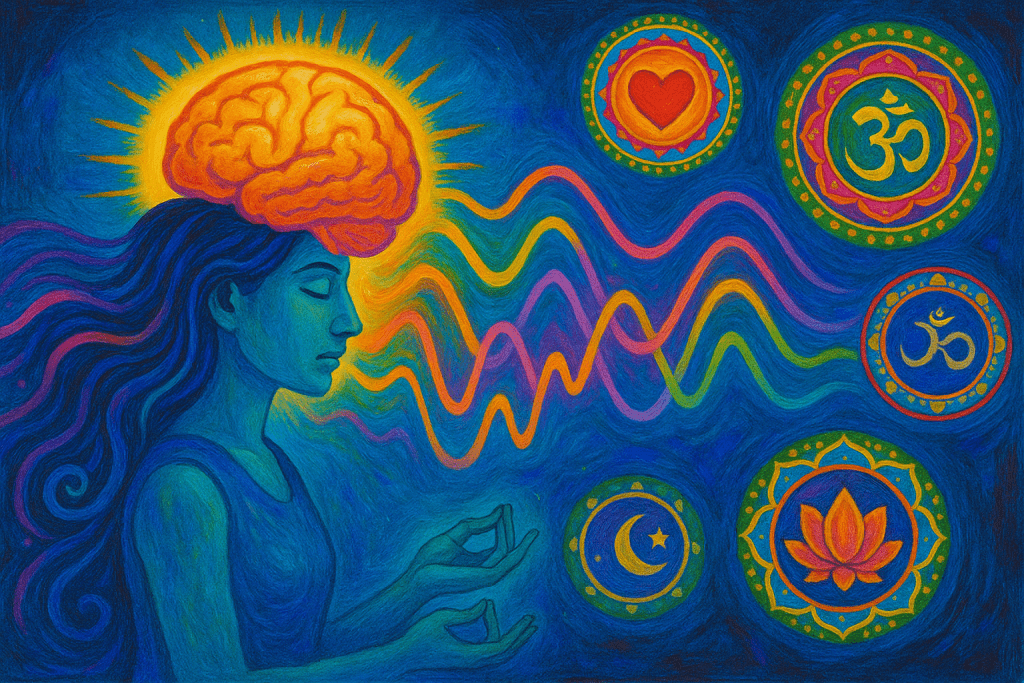
What Are the Benefits of Brainwave Entrainment?
Ever wish you had a “reset” button for your brain? That is basically what brainwave entrainment (BWE) offers and it is not science fiction. Let us break it down and explore how this powerful, often underrated tool can change your mental game for good.
Introduction to Brainwave Entrainment
What is Brainwave Entrainment?
Brainwave entrainment is a fancy way of saying you’re syncing your brain to a specific rhythm. The basic principles of brainwave entrainment are based on the frequency following response, a phenomenon where the brain’s electrical activity synchronizes with the frequency of external rhythmic stimuli.
It uses sound, light, or vibration to influence your brain’s natural frequencies helping your mind shift into different states, like deep focus, relaxation, or creativity. Common methods include audio entrainment, which uses sound-based techniques like binaural beats and isochronic tones, and audio visual entrainment, which combines auditory and visual stimuli to induce specific mental states.
Think of it like tuning a radio: each station (or brainwave frequency) brings a different vibe.
A Brief History of Brainwave Technology
While the science might sound new-agey, the roots of entrainment go way back. Ancient civilizations used rhythmic drumming, chanting, and light patterns to induce trance states.
In fact, ancient cultures around the world developed rhythmic and auditory practices specifically to influence mental and spiritual states, laying the groundwork for later techniques. Early experiments with photic stimulation, such as flashing lights, were explored for their ability to alter consciousness and even found medical applications like epilepsy diagnosis.
Today, we have binaural beats and smartphone apps doing the same thing — just with a bit more tech and science behind them. This evolution has led to modern brainwave entrainment, which uses advanced methods like isochronic tones and photic stimulation to achieve precise and consistent brain state changes.
How It Works (Simple Explanation)
Your brain is electric literally. It produces brainwaves, and each one corresponds to a different state of mind. Periodic stimuli, such as rhythmic sounds or pulsing lights, act as external stimulus to influence brainwave activity.
When you listen to specific sounds or see pulsing lights at a certain frequency, your brain tries to match it. This syncing process is called “entrainment” and leads to brainwave synchronization.
The Science Behind Brainwave Entrainment
Understanding Brainwaves: Delta, Theta, Alpha, Beta, Gamma
Here’s the cheat sheet:
- Delta (0.5–4 Hz): Deep sleep, healing, unconscious mind (frequency range: 0.5–4 Hz)
- Theta (4–8 Hz): Dreamy, meditative, intuitive (frequency range: 4–8 Hz)
- Alpha (8–12 Hz): Relaxed focus, calm alertness (also called alpha rhythm; frequency range: 8–12 Hz)
- Beta (12–30 Hz): Active thinking, focus, anxiety (frequency range: 12–30 Hz)
- Gamma (30+ Hz): High-level cognition, peak focus, insight (frequency range: 30+ Hz)
These brain waves are electrical oscillations in the brain, each with its superpower. The goal of BWE? Tap into the one you need, when you need it.
How External Stimuli Syncs Brainwaves
By presenting rhythmic sounds (like binaural beats), your brainwaves naturally adjust to match the external frequency through methods such as audio entrainment and auditory beat stimulation. That means if you listen to a 10 Hz tone, your brain will lean into alpha mode — ideal for relaxed focus.
The synchronization relies on specific frequencies, and the process is driven by the frequency following response, where the brain’s electrical activity aligns with the rhythm of the external stimulus.
Common Tools Used (Binaural Beats, Isochronic Tones, Light Pulses)
- Binaural Beats: Two tones of slightly different frequencies are played in each ear, creating a perceived third “phantom” tone — your brain locks onto that frequency. These are generated from pure tones and are a key example of how binaural and monaural beats use slightly different frequencies to influence brainwave patterns.
- Isochronic Tones: Single tones of the same frequency pulse on and off, producing a rhythmic pulsing sound that is easily recognized. Isochronic tones do not require headphones and can be embedded in music or nature sounds for enhanced relaxation.
- Monaural Beats: Monaural beats are created by combining two tones before they reach the ears, so the effect can be heard through speakers without headphones. Unlike binaural beats, which require each ear to receive a different frequency, monaural beats use the combination of two tones to produce a beat that is perceived by both ears together. Binaural and monaural beats are both used for brainwave entrainment but differ in their delivery methods.
- Light Pulses: Visual flickers, such as flashing light, flickering lights, and strobe lights, are used as visual stimuli and can be synchronized with audio for deeper effects. These visual stimuli influence the visual cortex, which is larger than the auditory cortex, making visual entrainment especially impactful.
Devices that use audio visual or synchronized auditory and visual stimuli combine these methods to enhance brainwave entrainment and support relaxation, focus, and mental wellness.
Key Benefits of Brainwave Entrainment
Improved Focus and Mental Clarity
Got brain fog? BWE helps clear it up by nudging your brain into beta or low gamma waves, sharpening your attention and clarity, and providing enhanced focus as a key benefit.
In addition to improved focus, brainwave entrainment is also known for its role in cognitive enhancement, supporting better memory, learning, and overall brain function.
Ideal for Students and Professionals
Struggling with distractions? Try alpha for calm concentration or beta for laser-sharp focus. Perfect during study marathons or tight deadlines.
Better Sleep and Relaxation
Struggling to switch off at night? Achieving deep relaxation is a key benefit, as delta and theta frequencies are your best bedtime buddies.
Delta and Theta Waves for Deep Rest
Listening to low-frequency beats before bed slows your brain down — helping you drift into restorative sleep faster and stay there longer.
Enhanced Meditation and Mindfulness
Want to meditate but your mind races like a hamster on espresso? Brainwave entrainment can help you achieve a meditative state by synchronizing your brainwaves with theta or alpha tones, guiding your brain gently into that quiet, introspective zone.
Reduced Anxiety and Stress Levels
Chronic stress messes everything up — sleep, energy, mood. Brainwave entrainment helps reduce cortisol levels and promotes a calmer, more balanced nervous system.
Cortisol Reduction and Mood Regulation
By shifting into alpha or theta, your brain tells your body, “We’re safe. Chill out.” This eases tension and boosts serotonin levels naturally.
Boosted Creativity and Problem Solving
Stuck in a rut? Try theta waves. They unlock imagination, “aha!” moments, and deep intuition. Ideal for writers, artists, or anyone stuck in the loop of overthinking.
Emotional Healing and Trauma Recovery
Increased Energy and Motivation
Oddly enough, certain frequencies (like beta and gamma) can leave you feeling more energized and driven like a double shot of espresso without the crash.
Support for ADHD and Cognitive Disorders
Brainwave entrainment may help with various health conditions, including those related to cognitive function. Several studies suggest entrainment helps improve attention spans, reduce hyperactivity, and enhance cognitive performance in those with ADHD and similar conditions.
Brainwave Entrainment vs. Other Techniques
How It Compares to Meditation and Hypnosis
Meditation takes time. Neurofeedback meditation can provide all the benefits of traditional meditation, such as improved mental clarity and relaxation, plus additional advantages like direct brainwave feedback and enhanced self-regulation. Hypnosis? Not for everyone. BWE helps you shortcut your way into those altered states no guru-level discipline required.
Natural vs. Technological Methods
Sure, you can train your brain naturally yoga, breathwork, chanting. But if you’re short on time or patience, tech-based entrainment can accelerate the process. Brainwave entrainment is a noninvasive method for influencing brain activity, offering a safe alternative to more invasive procedures.
Risks, Myths & Misunderstandings
Is Brainwave Entrainment Safe?
Debunking Common Myths
- “It will brainwash me.” Nope. It just syncs your brainwaves.
- “It’s addictive.” Not unless relaxation is your drug of choice.
- “Only works if you believe in it.” It is physics, not faith.
How to Get Started with Brainwave Entrainment
Choosing the Right Frequency
- Sleep: Delta (0.5–4 Hz)
- Meditation: Theta (4–8 Hz)
- Focus: Alpha/Beta (8–30 Hz)
- Creativity: Theta/Gamma
When choosing a frequency, it’s important to understand the frequency range associated with each brainwave type and select specific frequencies that match your desired mental state. Accurate synchronization to these specific frequencies can help achieve targeted effects.
Start slow. Listen for 10–15 minutes and observe how you feel.
Best Devices and Apps
- Brain.fm
- Insight Timer
- Braintap
- YouTube (search for: binaural beats or isochronic tones)
Most apps come with categories like “focus,” “sleep,” “relax” — making it super easy. Some also offer audio visual entrainment and light meditation options for enhanced relaxation and brainwave synchronization.
Daily Routine Examples
- Morning: Beta for alertness
- Afternoon: Alpha for focus
- Evening: Theta or delta for winding down
- Before creative work: Gamma or theta
Final Thoughts
Brainwave entrainment is not some woo-woo gimmick it is a practical, science-backed way to hack your brain for the better. Whether you want to focus more, stress less, sleep deeper, or create like a genius, this tool can make it happen.
So plug in, tune your brain, and get ready to unlock a version of yourself that is sharper, calmer, and way more dialed in.
FAQs
Some people feel calmer or more focused within minutes. Long-term effects (like better sleep or reduced anxiety) usually show up after consistent use for 1–2 weeks.
Absolutely! Many people use it daily as part of their routine just match the frequency to your goal and do not overdo it.
In general, low-frequency audio (like theta for sleep or calm) can be safe under supervision. But always consult a pediatrician first.
Yes especially for binaural beats (they rely on left-right audio differences). Binaural beats work by playing different frequencies in each ear, with the left ear and one ear each receiving a distinct tone; this creates a perceived beat in the brain. Isochronic tones, on the other hand, work fine with speakers.




